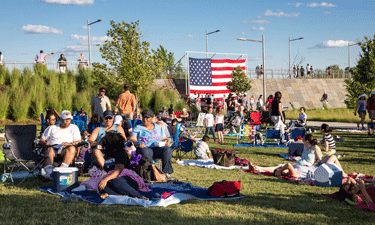 Essential Information
Essential Information
26 square miles, 14 community centers, 73 playgrounds, 89 outdoor tennis courts, 63 outdoor basketball courts, four spraygrounds, one skatepark, six senior centers, 77 rectangular fields, 54 diamond fields, one climbing wall, eight dog parks, eight community gardens, 174 parks, 44,000 park trees cared for, 19,000 street trees cared for, one disc golf course, two nature centers, five half-day preschool programs, three elementary after-school programs, six teen after-school programs at community centers and 30.5 miles of trails maintained.
A Model for Sustainability
Arlington County Department of Parks and Recreation (DPR) has proven nimble and prescient in its park planning, construction and community outreach. The agency serves an ever-changing mix of city dwellers, commuters and tourists who have high expectations when it comes to recreational offerings. “Arlington’s population continues to grow and become much more diverse within its 26-square-mile footprint,” says DPR Director Jane Rudolph. “DPR strives to accommodate our changing, more densely populated county with cutting-edge urban parks such as James Hunter and Long Bridge, as well as steward our remaining natural resources guided by our Natural Resources Management Plan.”
Indeed, James Hunter Park incorporates a wide array of activities including a passive area for open play or picnicking, a “community canine area” where dogs and their humans can meet and interact and a community demonstration garden boasting more than 40 varieties of native plantings. Less obvious is the park’s innovative construction, which serves as a model for sustainable design. Its lighting, displays, water feature and irrigation system all are powered via solar panels. Rainfall is collected, purified and stored in large underground cisterns that provide a constant supply of clean water for irrigation. Permeable pavement surfaces include recycled materials, adding yet another “green” layer to James Hunter Park.
For its part, Long Bridge Park is an example of successful reclamation of a previously blighted site. Planners transformed a formal industrial area to accommodate the park and reused dirt from a nearby water treatment plant in construction. Three acres of rain garden plantings help to manage stormwater runoff from the park’s sports fields, which occasionally play host to practice sessions for Washington, D.C.’s Major League Soccer team, DC United.
Both parks give a nod to Arlington residents’ and visitors’ taste for clever and unique art — the signage at James Hunter Park was created through a public art project and Long Bridge Park plays host to an impressive sculpture by artist Doug Hollis. His “Wave Arbor” installment includes two kinetic wind-activated pieces that morph and change with the breeze.
These initiatives represent an ongoing philosophy at DPR, according to Rudolph. “As DPR works through its capital projects, it continues to look for innovative designs and technologies,” she says. “We’re [in the process of] building our first Universal Design Playground, and we always look for environmentally friendly features like solar power, porous pavement and rain gardens in our renovations.”
Community Service
Complementing its outdoor parks and play areas are DPR’s programmatic offerings and community centers. From youth to seniors, DPR carefully considers the needs of its constituents and strives to infuse traditional recreational activities with modern considerations like healthy eating. “To combat childhood obesity and empower the community to develop healthy lifestyles, DPR has created policies that require healthy eating and physical activity standards in all its youth programs, placed only healthy vending machines — branded FitArlington — in its parks, centers and all county office buildings and schools, developed ongoing messaging to remind people to not smoke in parks, and included asset-building curricula in youth and teen programs,” says Rudolph.
“Our senior centers are focused on helping residents flourish after 55,” she continues. “While we have traditional clubs and meal programs, DPR also has robust senior sports and fitness programs, community service projects, classes on cybersecurity, brain games and art history, and lots more to help older residents thrive. An offshoot from one of our programs is Arlington Villages, a new nonprofit that helps residents develop resources and networks to age safely and healthfully in their homes.”
DPR’s Walter Reed Community Center is a prime example of its commitment to the area’s senior population, as well as sustainable design. The center features a gym, game area, art room, community computers — free public Wi-Fi included — meeting rooms, multipurpose rooms, outside tennis courts, basketball courts, a playground and gardens. Its Adult Day Health Care Center helps visitors with functional limitations maintain or enhance their independence, while its onsite Senior Center offers a variety of programs for active seniors.
Walter Reed Community Center is also certified to silver-level LEED standards and features a vegetated roof, low-flow toilets, faucet aerators and still other green features. The building was constructed with regional materials and wood certified by the Forest Stewardship Council.
While the above examples are but a snapshot of all DPR has to offer, they illustrate well the innovative and responsive approach the agency assumes when it comes to community service. Learn more about DPR’s programming, parks and ongoing projects.
Samantha Bartram is the Associate Editor of Parks & Recreation magazine.

